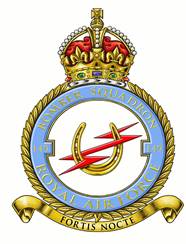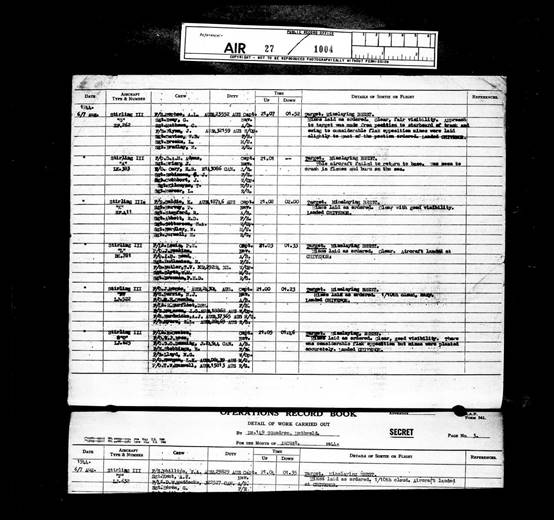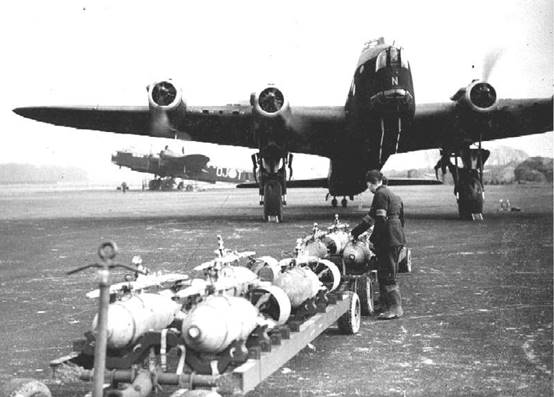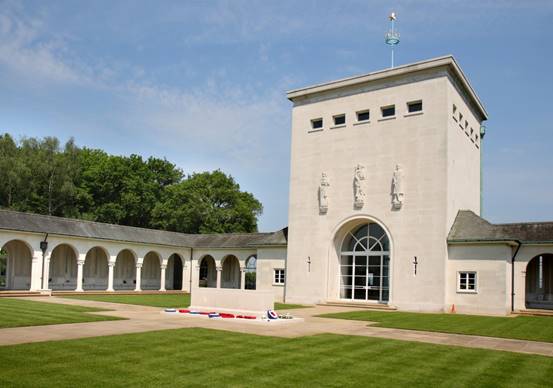|
|
-
173518 Flying Officer D. A. M. Adams
-
Pilot, RAFVR
-
149 (East India Sqn) RAF
-

-
-
Douglas Adams was killed when the aircraft he was piloting crashed into the English Channel.
-
-
The Aircraft was a Mk III Short Stirling, serial number LK383 and coded OJ-A on the strength of 149 (East India) Sqn, RAF. It had arrived on the Sqn on the 14th June 1944, following repair after an accident whilst with 90 Sqn. On its final mission it was crewed by:
-
-
F.O. D A M Adams Pilot
- Sgt J A Prior Navigator
- P.O. E S Carey RCAF Air Bomber
- Sgt J E A Cuthbert Wireless Operator
- Sgt T Kilcoyne M/U/Gunner
- Sgt J W Robinson Flight Engineer
- Sgt L M Mercer Rear Gunner
-

-
-
The aircraft took off from Methwold at 21.01hrs and failed to return. All on board died and are commemorated on the Runnymede Memorial.
-

-
F.O. D A M Adams, Panel 204, Runnymede Memorial
-
The following is a scanned copy of the Squadron ORB (Operational Record Book) for the last Operation of OJ-A LK383. (2nd Entry)
-

-
-
F.O. Adams had, at the age of 30, flown four Ops before this, all with the same crew. It is interesting to speculate on Douglas’s age and rank. This would indicate that he was either a promoted NCO Pilot on his second tour or a University educated guy who entered the VR at the top end of the age restrictions. If it was the latter, he probably joined the RAF in 1942, and did his Elementary Flying Training in the UK; the usual aircraft was the DH 82 Tiger Moth. He could well have been one of the student pilots sent to America under the Arnold Scheme.
- After completing his flying training he would have been posted back to the UK, probably in late 1943, and from there to a Heavy Conversion Unit to learn to fly the Stirling Bomber. During that time the final crew would have teamed up. Completing the conversion training, he was posted with his crew as an “operational crew” to 149 (East India) Squadron, flying Stirling III Bombers out of Methwold.
-

- Picture source - IWM
-
- 1st Operation.
- The first trip for the crew with 149 Sqn was a Mine-laying operation to the La Rochelle area, which was successfully carried out with no incident.
-
- 2nd Operation.
- Was minelaying to Les Landes, with another successful trip.
-
- 3rd Operation
- Was a return trip to Les Landes, with yet more Mines.
-
- 4th Operation.
- Was minelaying to Foret-de-Nieppe; again successful.
-
- 5th Operation
- Was again mine-laying, to Brest. During the return trip OJ-A was seen to descend into the Channel in flames and burn on the surface. None of the crew survived and no bodies were recovered. There are no Night Fighter claims for that night, so it must be assumed that the intensive Flak reported by other crews started fires on board, or that a technical malfunction brought them down.
-
- The Runnymede Memorial.
-
Over the War years, many aircraft were despatched on Operations, never to be heard from again. The losses were attributed to many causes, some discovered after the War and others unsolved to this day. Many relatives have tried in vain to find out what happened to their loved ones. Others have found their peace.
-
The Runnymede Memorial, below, is a tribute to all who have been lost and have no known resting place.
-

-
-
They went with songs to the battle, they were young.
- Straight of limb, true of eyes, steady and aglow.
- They were staunch to the end against odds uncounted,
- They fell with their faces to the foe.
-
They shall grow not old, as we that are left grow old:
- Age shall not weary them, nor the years condemn.
- At the going down of the sun and in the morning,
- We will remember them.
-
All of the crew of LK383 were lost without trace and are remembered on the Runnymede Memorial.
-
-
Some of the Mine-Laying Areas referred to in the text are shown below.
-
-
-
Since completing this account I have been contacted by relatives of the Navigator, Sgt J A Prior, who will receive an account based on his service.
-
Return to Index
Return to Index
|
|
|
 Stirling Pilott
Stirling Pilott 
 Stirling Pilott
Stirling Pilott 